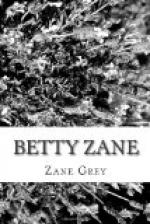If we may believe what these men have said—and there seems no good reason why we may not—the Indian was very different from the impression given of him. There can be little doubt that the redman once lived a noble and blameless life; that he was simple, honest and brave, that he had a regard for honor and a respect for a promise far exceeding that of most white men. Think of the beautiful poetry and legends left by these silent men: men who were a part of the woods; men whose music was the sighing of the wind, the rustling of the leaf, the murmur of the brook; men whose simple joys were the chase of the stag, and the light in the dark eye of a maiden.
If we wish to find the highest type of the American Indian we must look for him before he was driven west by the land-seeking pioneer and before he was degraded by the rum-selling French trader.
The French claimed all the land watered by the Mississippi River and its tributaries. The French Canadian was a restless, roaming adventurer and he found his vocation in the fur-trade. This fur-trade engendered a strange class of men—bush-rangers they were called—whose work was to paddle the canoe along the lakes and streams and exchange their cheap rum for the valuable furs of the Indians. To these men the Indians of the west owe their degradation. These bush-rangers or coureurs-des-bois, perverted the Indians and sank into barbarism with them.
The few travellers there in those days were often surprised to find in the wigwams of the Indians men who acknowledged the blood of France, yet who had lost all semblance to the white man. They lived in their tepee with their Indian squaws and lolled on their blankets while the squaws cooked their venison and did all the work. They let their hair grow long and wore feathers in it; they painted their faces hideously with ochre and vermilion.
These were the worthless traders and adventurers who, from the year 1748 to 1783, encroached on the hunting grounds of the Indians and explored the wilderness, seeking out the remote tribes and trading the villainous rum for the rare pelts. In 1784 the French authorities, realizing that these vagrants were demoralizing the Indians, warned them to get off the soil. Finding this course ineffectual they arrested those that could be apprehended and sent them to Canada. But it was too late: the harm had been done: the poor, ignorant savage had tasted of the terrible “fire-water,” as he called the rum and his ruin was inevitable.
It was a singular fact that almost every Indian who had once tasted strong drink, was unable to resist the desire for more. When a trader came to one of the Indian hamlets the braves purchased a keg of rum and then they held a council to see who was to get drunk and who was to keep sober. It was necessary to have some sober Indians in camp, otherwise the drunken braves would kill one another. The weapons would have to be concealed. When the Indians had finished one keg of rum they would buy another, and so on until not a beaver-skin was left. Then the trader would move or when the Indians sobered up they would be much dejected, for invariably they would find that some had been wounded, others crippled, and often several had been killed.




